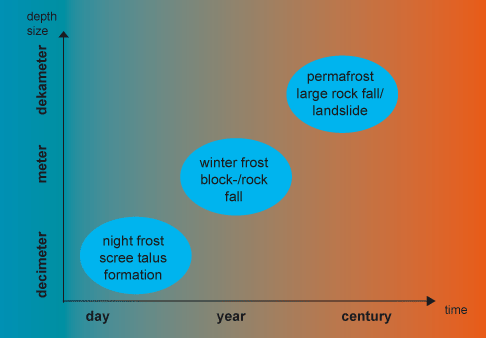|
Decimeter-to-meter scale:
This corresponds to the classic "volume expansion model" which explains rock destruction primarily by the
volume expansion during freezing of a closed water/ice-system in fissures and cracks. Field and laboratory
experiments indicate that surface conditions (wetness, snow) have a strong influence on the quantity of rock
particles released.
Meter-to-dekameter scale:
At lower frequencies (seasons) and greater depths, the most effective
process in rock destruction appears to be the formation of ice lenses in porous rocks by continued water
flux towards the freezing front in an open system of cracks, fissures and pores. Optimal fracture propagation in common lithologies thereby takes place
at temperatures between about -3°C and -6°C. Sustained subzero temperatures are more important than the number of
high-frequency freeze/thaw cycles. Optimal conditions for fracturing require both high temperature gradients and
the availability of moisture. Indeed, an activity peak does occur
in springtime, when the release of latent heat from meltwater percolation through snow into the still
cold, active layer over permafrost creates these ideal conditions. In contrast temperatures in permafrost areas, ground temperatures
beneath thick snow in winter and spring at permafrost-free sites are known to be close to, or even at, the freezing
point, and rock destruction by ice segregation would be much less intense.
This rather new "ice segregation model" helps us to
understand, why (cold) walls in the shade are often more
affected than (warm) walls exposed to the sun. It also helps to explain why the maximum intensity of rock
fracturing must be expected in the permafrost table, where the temperature/moisture conditions are ideal,
rather than at the surface.
The influence of permafrost on frost weathering and destabilization of
rock walls has so far remained a virtually untouched field of research.
The most important processes concern the fracturing of rocks during freezing,
the change in hydraulic conductivity and pore water pressure/circulation
during freezing/thawing and the change in surface geometry by major rockfalls.
|




